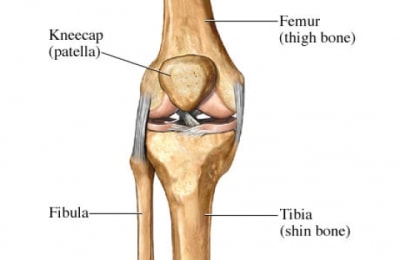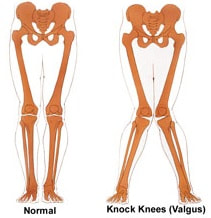Part 3 – Knee Pain
(Including: Patella Femoral Pain Syndrome, Patellar Tendinopathy, Arthritis)
The knee is arguably the largest joint in the human body. It is comprised of four bones, the patella, femur, tibia, and fibula. The three most common knee pain diagnoses I treat are Osteoarthritis, Patella Femoral Pain Syndrome, and Patellar Tendinopathy.

Osteoarthritis (OA) is part of a natural degenerative cascade that effects everyone. This is not to be confused with rheumatic arthritis which is an auto-immune related, chronic inflammatory disorder. Imaging reveals OA in both symptomatic and asymptomatic patients in various body regions, sometimes beginning as early as the third decade of life. Prevalence is highest amongst those over 65 years of age. Before becoming painful and restrictive, arthritic joints are often joints that get utilized most in the body. This is sometimes portrayed as a protective mechanism against uneven wear and tear on the body, perhaps due to an inability or unwillingness to allow neighboring joints to contribute to motion.
Patellar Tendonitis is a pathology characterized by inflammation of the patellar tendon. Unlike arthritis, this is an acute condition that is reversible. It is brought on by improper loading of the tendons secondary to either poor mechanics of movement or improper loading rate/frequency.
Patella-femoral pain syndrome (PFPS) is knee pain around the patella that otherwise cannot be attributed to anything else. It is a diagnosis that literally translates to “pain around the knee cap.” Unlike the aforementioned knee pathologies, with PFPS there does not have to be a compromise in structural integrity of the joint or its surrounding tissues. Oftentimes, symptoms are resolved with improving the quality of movement that the patient or client is performing.
To be succinct, all of these diagnoses involve poor movement, stressing various tissues, and manifesting as knee pain. The knee joint is fundamentally a hinge joint, meaning, similar to opening your front door, it moves in one plane. With the exception of some rotary motion, the knee primarily flexes and extends (i.e. bends and straightens). For a hinge joint to get faulty motion, there is usually a force being enacted on the joint in directions outside of its intended range; think of hanging from your front door as its opening.
But how and why are these sub-optimal forces placed on the knee? Well, most of the painful knee movements involved closed chain activity, meaning that the foot is affixed to a surface as the knee is moving (i.e. going up/down a flight of stairs, squatting, or stooping). Considering the foot is fixed, the main joint that determines where that knee will be in space, is the hip. The hip moves the leg side to side and will ultimately determine which forces are imposed at the knee. A commonly seen problem, is that when the hip is weak, the knee may move inwards during a lunge, squat, or a step.

So how may Conventional Powerlifting training help?
Almost all main powerlifting movements involve utilizing the hip musculature. Even in a bench press, the client is trained do drive through the legs, utilizing the hips to improve stability of the body during the exercise. In order to generate more force, the hip must be trained to stabilize the knees in a neutral position, as the knees come outside of the position, the body sacrifices its structural integrity, which will result in poor performance.
Proper alignment during movement and exercise will also yield increased joint space which is imperative when a space occupying lesion, such as osteoarthritis, is present in the joint. So, moving with proper mechanics will increase pain free range of motion within these movements. Many of the lower extremity movements we perform throughout the day involve a squat or hinge, which are key components of the back squat and deadlift exercise respectively.
Mal-alignment of the joint may also result in PFPS considering the forces enacted around the patella may be stronger on one side than the other. Considering the patella is a free-floating bone, this may create issues on how that patella tracks during movement. One of the principles of a sound squat and deadlift includes aligning the knees with the toes in order to generate more force. When done correctly, this promotes proper strength and stability around the joint, and optimal movement around the functional patterns being trained. This also enables the hips to contribute more to the movement, which involves muscles that have larger force generating capabilities than those that surround the knee joint. Literature currently suggests that hip strengthening should be a key component of PFPS rehabilitation likely for the aforementioned reasons.
As stated before, tendons respond to improper loading. Sometimes the form can be perfect, but the body is asked to do to much over too short of a time without the proper conditioning. This is usually seen when the total volume of work is increased beyond the body’s ability to recover. During rehabilitation, volume is scaled back considerably and exercise intensity increases as per the patient’s tolerance. This very closely emulates the programming of powerlifters!
How do I get started?
Sold already, but don’t know where to start? No worries! I have posted directories below that will point you in the right direction so you can find skilled practitioners in your area.
– If you’re local to the Charlotte Area, The Charlotte Athlete is a group of healthcare providers and highly accredited sports doctors that specialize in various sports setting including Powerlifting, Bodybuilding, Strongman, Olympic Weightlifting, Crossfit, and recreational athletes and youth athletes. There is also free, quality, information on how to improve your lifts and ways to work around common aches and pains. Hit us up!
– This is the directory for the American Board of Physical Therapy Specialties (ABPTS). There are options to search within each specialty. An orthopedic specialist would be able to help best with nagging aches and pains and help get you back to sport specific training. A sport specialist may help you overcome, manage, or avoid injury within your sport. Some Sport Specialists have a subspecialty with a specific sport, or set of sports.
– This is a directory of Strength and Conditioning Specialists that are registered with the National Strength and Conditioning Association (NSCA). This directory allows you to filter by location and search based on years of experience. Peruse this directory to find a Strength and Conditioning Specialist in your area.
Author: Dr. Michael Masi

